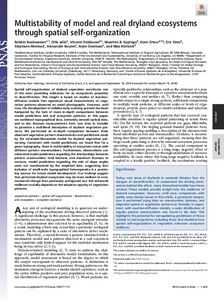| dc.contributor.author | Bastiaansen, R. |
| dc.contributor.author | Jaibi, O. |
| dc.contributor.author | Deblauwe, V. |
| dc.contributor.author | Eppinga, M.B. |
| dc.contributor.author | Siteur, K. |
| dc.contributor.author | Siero, E. |
| dc.contributor.author | Mermoz, S. |
| dc.contributor.author | Bouvet, A. |
| dc.contributor.author | Doelman, A. |
| dc.contributor.author | Rietkerk, M. |
| dc.date.accessioned | 2019-12-04T11:26:33Z |
| dc.date.available | 2019-12-04T11:26:33Z |
| dc.date.issued | 2018 |
| dc.identifier.citation | Bastiaansen, R., Jaïbi, O., Deblauwe, V., Eppinga, M.B., Siteur, K., Siero, E., ... & Rietkerk, M. (2018). Multistability of model and real dryland ecosystems through spatial self-organization. Proceedings of the National Academy of Sciences, 1-6. |
| dc.identifier.issn | 0027-8424 |
| dc.identifier.uri | https://hdl.handle.net/20.500.12478/4647 |
| dc.description | Published online: 15 Oct 2018 |
| dc.description.abstract | patial self-organization of dryland vegetation constitutes one of the most promising indicators for an ecosystem’s proximity to desertification. This insight is based on studies of reaction–diffusion models that reproduce visual characteristics of vegetation patterns observed on aerial photographs. However, until now, the development of reliable early warning systems has been hampered by the lack of more in-depth comparisons between model predictions and real ecosystem patterns. In this paper, we combined topographical data, (remotely sensed) optical data, and in situ biomass measurements from two sites in Somalia to generate a multilevel description of dryland vegetation patterns. We performed an in-depth comparison between these observed vegetation pattern characteristics and predictions made by the extended-Klausmeier model for dryland vegetation patterning. Consistent with model predictions, we found that for a given topography, there is multistability of ecosystem states with different pattern wavenumbers. Furthermore, observations corroborated model predictions regarding the relationships between pattern wavenumber, total biomass, and maximum biomass. In contrast, model predictions regarding the role of slope angles were not corroborated by the empirical data, suggesting that inclusion of small-scale topographical heterogeneity is a promising avenue for future model development. Our findings suggest that patterned dryland ecosystems may be more resilient to environmental change than previously anticipated, but this enhanced resilience crucially depends on the adaptive capacity of vegetation patterns. |
| dc.description.sponsorship | National Key Research and Development Program, China |
| dc.description.sponsorship | National Natural Science Foundation of China |
| dc.description.sponsorship | European Union |
| dc.format.extent | 1-6 |
| dc.language.iso | en |
| dc.rights | Other |
| dc.subject | Vegetation |
| dc.subject | Arid Zones |
| dc.subject | Ecosystems |
| dc.subject | Resilience |
| dc.title | Multistability of model and real dryland ecosystems through spatial self-organization |
| dc.type | Journal Article |
| dc.description.version | Peer Review |
| cg.contributor.affiliation | Leiden University |
| cg.contributor.affiliation | International Institute of Tropical Agriculture |
| cg.contributor.affiliation | University of California |
| cg.contributor.affiliation | Utrecht University |
| cg.contributor.affiliation | Royal Netherlands Institute for Sea Research |
| cg.contributor.affiliation | East China Normal University |
| cg.contributor.affiliation | Carl von Ossietzky University Oldenburg |
| cg.contributor.affiliation | Institut de Recherche pour le Développement |
| cg.creator.identifier | Vincent Deblauwe: 0000-0001-9881-1052 |
| cg.researchtheme | NATURAL RESOURCE MANAGEMENT |
| cg.isijournal | ISI Journal |
| cg.authorship.types | CGIAR and developing country institute |
| cg.iitasubject | Natural Resource Management |
| cg.journal | Proceedings of the National Academy of Sciences of the United States of America |
| cg.howpublished | Formally Published |
| cg.accessibilitystatus | Limited Access |
| local.dspaceid | 101392 |
| cg.targetaudience | Scientists |
| cg.identifier.doi | https://dx.doi.org/10.1073/pnas.1804771115 |

